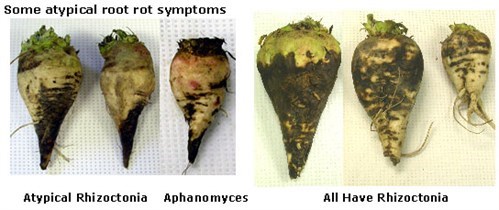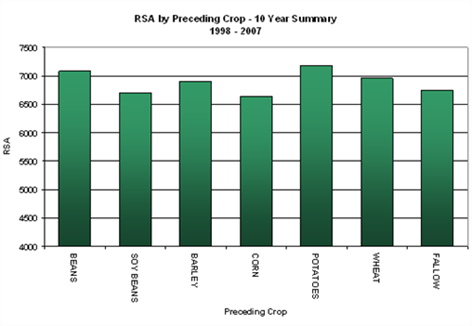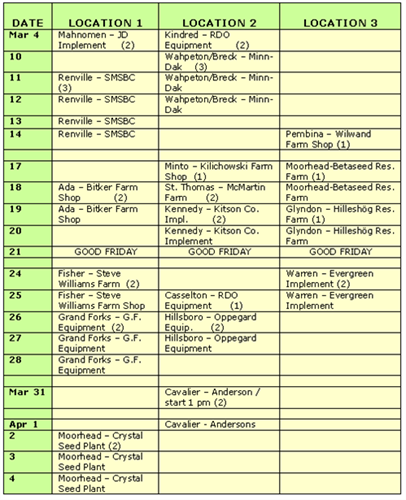507 - Rhizoctonia Threat Increasing
Rhizoctonia has been present in the beet crop since it was first grown in the Red River Valley. In the last 10 years most growers have observed a significant increase in not only incidence but, also severity of this disease.
Many Factors Influence Incidence and Severity of Rhizoctonia
- Length of crop rotation
- Previous crop grown before sugarbeet
- Variety resistance level
- Cultural practices - cultivation, rotary hoeing
- Weather patterns
Changes in cropping patterns in the Red River Valley point to even more Rhizoctonia in the future. Soybean and dry edible bean crops, in particular, increase Rhizoctonia inoculum in the soil. Corn also increases inoculum especially for one specific type of Rhizoctonia. Soybean, edible bean, and corn acres are increasing in the Red River Valley. Wheat is the best rotational crop for reducing Rhizoctonia inoculum in the soil and threat of the disease. Wheat acreage declined by more than 1 million acres since 1995, but may increase in 2008 with improved prices, Table 1.
Table 1. Changes in crop acres from 1995 to 2006 in the RRV of Minnesota & North Dakota.
| Acres | |||
|---|---|---|---|
| Crop | 1995 | 2006 | Change |
| Sugarbeet | 501,200 | 616,900 | +115,700 |
| Bean Crops | 1,578,300 | 3,485,300 | +1,907,000 |
| Wheat | 3,430,400 | 2,268,500 | -1,061,900 |
| Corn | 655,100 | 1,022,800 | +367,700 |
| Source = National Ag Statistics Service - USDA | |||
Rhizoctonia inoculum effects on sugarbeet is specific to the previous crop grown.
- R. solani AG 2-2 IIIB on sugarbeet is most common following edible bean, intermediate after soybean, and lowest after potato
- Rhizoctonia root and crown rot on sugarbeet was highest in plots inoculated with R. solani AG 2-2 IIIB following corn, intermediate after soybean, and least after wheat
- Two strains of R solani 2-2 (IIIB and IV) were lowest after wheat/barley
Proper diagnosis of the disease in the field is critical. Rhizoctonia infection starting under dry conditions may look very much like Aphanomyces. Be sure you identify the specific disease carefully and know your crop history before you apply fungicides.

Rhizoctonia Control Measures
- Correct diagnosis of the disease
- Early planting
- Plant tolerant varieties
- Hilleshög 3035 = very good; Beta 1301R = good
- Use fungicides
- Avoid "hilling" - cultivation that throws soil into the crown area
- Weed control - to eliminate weed hosts
Fungicides Recommendations: Fungicides must be applied before infection occurs to be effective.
| Fungicide | Product/A (oz) | Approximate Lost ($) | Timing |
|---|---|---|---|
| Quadris | 9.5 - 14.3 | $20 - $32 | 8-12 leaf, before last cultivation |
| Proline | 5.7 | $18.50 | 8-12 leaf, before last cultivation |
The management scheme in Table 2 has proven effective in Michigan where Rhizoctonia can be very severe.
Table 2: Disease Severity + Variety + Quadris use strategies
| Severity of Rhizoctonia | Variety Type | Quadris 7 - Inch Band* |
|---|---|---|
| Light | Susceptible | 2/3 full rate |
| Moderate | Mod. Tolerant | 2/3 full rate |
| Most Tolerant | No | |
| Severe | Most Tolerant | Yes (full rate) |
| * A wider band reduces effective rate, a narrower band allows use of lower rate From: Mr. Steve Poindexter, Michigan State University Extension |
||
Caution: Don't mix Quadris with sugarbeet herbicides because crop injury can be very severe.
Contact your agriculturist for assistance with disease identification and to discuss control strategies.
Crop rotations For Profit
Changing crop choices for Red River Valley farmers is one of the tougher decisions that need to be made each year. Many factors enter in to these decisions including:
- Commodity prices
- Equipment availability
- Available labor
- Impact of crop sequence choices
- Disease management
- Fertilizer requirements for specific crops
- Fuel requirements for each crop
- Weed resistance management
Check with your agriculturist for crop rotation effects for your factory district or piler district. Local results may vary from the entire RRV data shown in Figure 1.
Figure 1. The impact of preceeding crop on recoverable sugar per acre from sugarbeets.

Recoverable sugar per acre is greatest following dry edible beans and potato. This may be in part due to the fact these crops are usually planted on soils that tend to be highly productive. Recoverable sugar per acre (RSA) following wheat and barley are very, very good even though planted on a very wide range of soil types on well over 3,000,000 acres in this 10 year period. Yields following soybean and corn are lowest. Factors that may reduce yields after soybean and corn might include:
- Increased Rhizoctonia incidence
- Less available soil water after longer season crops
- Deeper rooting and more subsoil water and nitrogen use than small grains, dry beans or potato
- Alleopathic effects
2008 Planter Test Stand Schedule

Starter Fertilizer
Check with your local dealers for availability of the starter product you have been using.
Educational Resource Materials Available
Contact your agriculturist or ag office coordinator for any of these brochures.
- 2008 Specifications for Proper Pesticide Use
- 2008 John Deere Planter Plate and Vacuum Settings Recommendations
- 2008 Recommendations For Monosem Plates
- Planter Operation Maintenance and Storage
- Fact Sheets:
- Zone Fertility Management
- Drainage Management
- Starter Fertilizer
- Mustang Max
- Stand Establishment
- Soil Applied Herbicide
- Growing Degree Days
International Sugarbeet Institute
Don't miss this opportunity to view the latest innovations. March 5 & 6 at the Alerus Center in Grand Forks
Thanks for dedicated service. Tom Zidon, EGF, Agriculturist will retire February 29, after 27 years of service to his growers.
Thanks
A special thanks to Dr. Carol Windels, U of MN for pictures and use of data in this Ag Notes.
